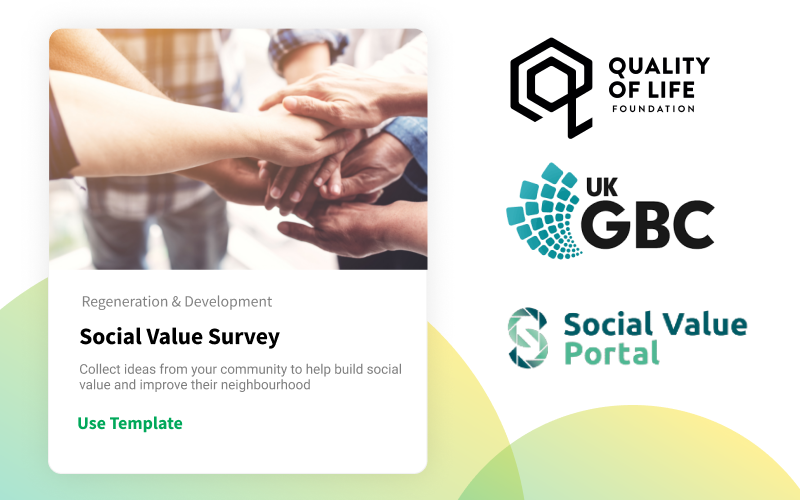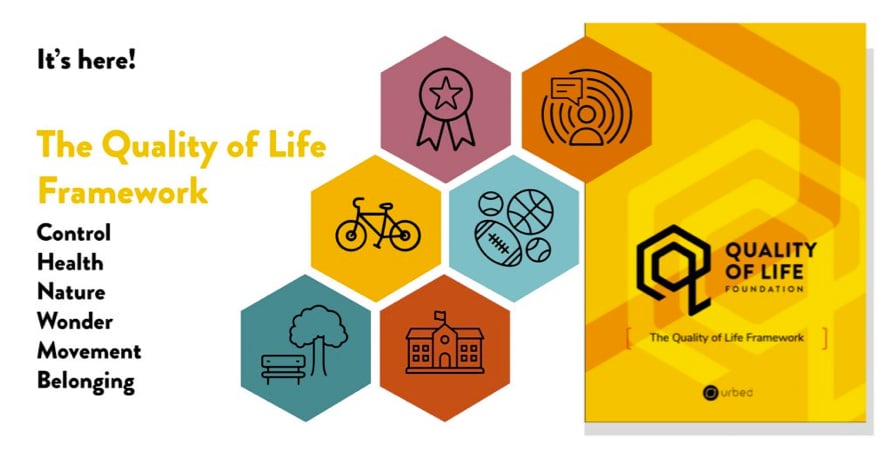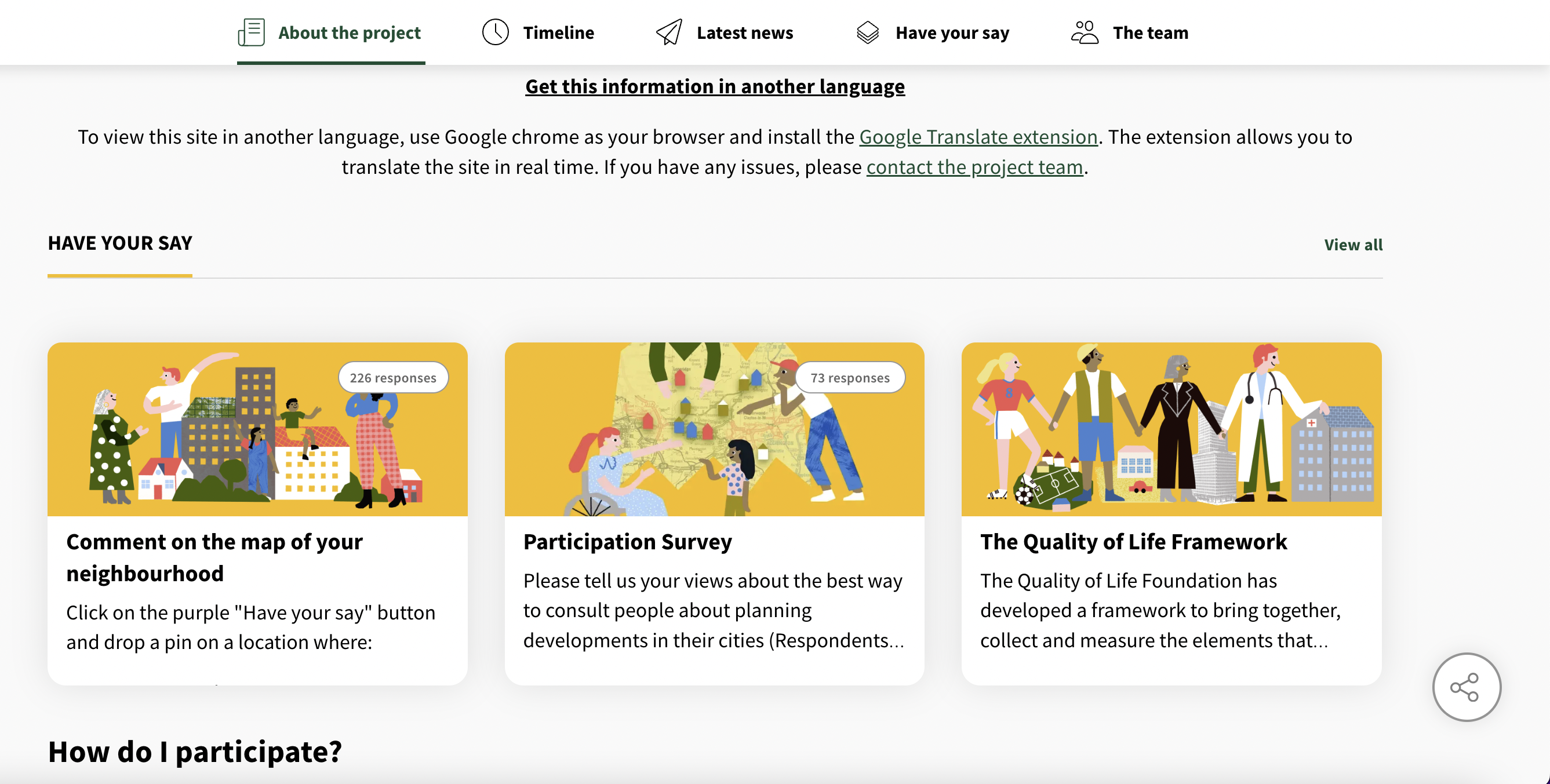Commonplace developer series: #4 social value

By Charlotte Cooper | 26/04/24 11:00
5 min read
It’s time for the penultimate instalment of our developer's series! Today, we’re covering how development and social value must go hand-in-hand in order to ensure fruitful economic growth in the built environment. These days, developers, housing associations and local authorities are working harder than ever to create successful and, more importantly, sustainable places that positively impact the wellbeing of the people who live and work there.
The consideration and application of social value for development is in rapid expansion - and for very good reason: it has the potential to measure the societal impact of a development on a place and the community. No matter the framework being used, whether it’s TOMs, the Quality of Life Framework, the Social Value Toolkit or the UK Green Building Council’s guidelines, the impact is ultimately all about people and it’s crucial that the perspectives of those affected by new developments are taken into account.
This, naturally, comes with questions. How can social value be measured? What does a social value framework look like? How do we combat short-term thinking in the built environment? This guide is here to give you an overview of social value, some methods of assessing it and the benefits these methods bring to projects in the long run.
Prefer a webinar? We recently hosted “Driving sustainable growth through Environmental Social Governance (ESG) standards” where a series of social value experts gave their view on how it affects the built environment.
The importance of Social Value

What is social value? In a nutshell, it’s understanding people’s lived experiences in places and how their homes and local areas affect their physical, social and psychological wellbeing. It’s also about bringing longer-term thinking into development plans to create better homes and improve the overall quality of life of the people who will live, work and play in these areas.
This is where the developers can struggle a little, as measuring such nebulous concepts is tricky. In our recent webinar on the subject, Senior Social Value Advisor at Social Value Portal, Olivia Sutcliffe, commented that “One question I get a lot is, ‘what does good look like in terms of social value?’ The answer is that there isn’t just one perfect answer. It varies from project to project and industry to industry.”
Experts are constantly looking at new ways to measure social value and people’s quality as it relates to the environment around them. It simply isn’t something that can be wholly measured in pounds and pence. Measuring is focussed on people’s lives and lived experiences, in and around developments.
How to use social value frameworks

This is where social value frameworks can be a huge help. As mentioned previously, planners and developers can have a hard time measuring their social value efforts which sometimes makes it tricky to find a place to start. With a social value framework, you can start with a benchmark of factors that have already proven to be important to the social value of a community. While all areas are different, a framework gives a strong starting point. For example, the Quality of Life Foundation’s framework was created a comprehensive literature review* to explore what was meant by ‘quality of life’ and how it is affected by the built environment. The report concluded that there was a general understanding that quality of life is ‘the level to which individuals may feel their lives to be happy, active, sociable, interesting and meaningful.’ Six key themes were then articulated against which to measure actual experience:
- Control
- Health
- Nature
- Wonder
- Movement
- Belonging
Multiple opinions of the community were tuned into data and used as a foundation to create these themes. Choosing to follow a framework like this can help developers preempt some of the issues that may currently exist and planners can see where there are deficits in social value.
Combatting short-term thinking
In the government, there can be an obsession with numbers: the number of units made and sold, profit maximisation and if a development is making any dent in the housing crisis. Creating a social value action plan is about building a more qualitative view of housing that asks whether those “housing units” add up to a neighbourhood that’s a sustainable and even joyful place for people to live and thrive.
Using a social value approach is an iterative, repeated process. It involves asking people about their aspirations before a development takes place and incorporating these aspirations into a development. When the development is populated, occupants can be asked at different points in time how well the locality functions in terms of social value. Using a consistent framework enables the changes to be quantified, and also facilitates valid comparisons between different developments.
This is where data and digital engagement come in, crystallising in a digital engagement strategy. A digital engagement strategy can act as a conduit to the community so their voices can more easily be heard. In any engagement, it’s crucial that you’re communicating with all key stakeholder groups and running a digital engagement alongside traditional field research and in-person events as this can help you reach as many of them as possible. This was mentioned by our Head of Private Sector, Cleo Weeden in our recent webinar. She pointed out four key areas where online platforms help:
- Reaching a target audience: By using social media plus the existing stakeholder groups to find people, you’re encouraging a more diverse audience engaging with the process.
- Broadening your reach: By using a digital engagement tool you’re getting meaningful engagement and can use the data to understand exactly who the community are and can target your efforts in other areas if you see certain demographics missing.
- Gathering robust data: You can get granular with your data and really get into the needs of these specific groups. By monitoring the changing trends, you can make decisions about your engagement quickly. Unless you go back to the community with the choices you make, they won’t know what you’re doing and not understand the amount of work going into these projects or ways in which they have been modified in response to feedback on social value. The responsiveness is, in itself, a component of social value, indicating a capacity to exert agency in one’s environment.
- Getting the community invested: Digital engagements can also show the community how their feedback is shaping plans. With tools like email alerts and a news feed, updates can be posted as they happen.
Using digital tools an audience can be reached repeatedly - enabling measurement of changes in appreciation of local social value over time.
We talked about this exact thing recently at UKREIIF 2023! Check out our full session packed with social value experts below!
Social Value example: Community Consultation for Quality of Life (CCQOL)

Let’s take a look at an example project: CCQOL (Community Consultation for Quality of Life). This was created in partnership with the Quality of Life Foundation (QoLF) and is a major research project led by the University of Reading to create a new map-based model of community consultation on social value. Taking place both online and face-to-face using “Urban Rooms”, the aim is to let people comment on interactive digital maps so QoLF can more easily measure the impact of changes to their neighbourhoods. Used alongside data collected by QoLF that measures social and environmental value, the different projects will be able to harvest new data continuously. So far, CCQoL launched three of four planned projects - each with the goal of empowering community voices and further developing the understanding of the quality of life in Reading, Cardiff and Edinburgh.
Cardiff Council has already been very receptive to the Urban Room and online exercise put on by CCQOL in Cardiff. The Urban Room was operated in Grangetown in May 2022 and offered local people a place to exhibit and discuss issues that affect the community around future development. They included themes of health and wellbeing, housing and community spaces, the natural environment and young people as well as the six themes in the QoLF framework. The data gathered here is already being used to develop best practice guidelines for community engagements that can express local views and desires and bring them to bear on development processes through credible data. The work in May this year has already shown its impact. A unique event was held in July 2022 at the Senedd (the parliament of Wales) to convey the experience of engaging all parts of the community in considering social value. The title of the gathering clearly stated its intention: “I am not hard to reach”. Cardiff City Council for its part has indicated that it would like to trial a participatory planning exercise in a part of Cardiff that’s based on the work of CCQoL. These shifting attitudes indicate both an idea whose time has come and the growing confidence in social value methodologies to underpin more systematic community engagement in place-shaping.
If you're ready to incorporate a social value strategy in your next project then Commonplace will always be here to help. Having worked with a number of social value experts, our team can help you create a solid digital strategy and assist in measuring the effectiveness of your scheme. Just give us a shout below!
*https://www.qolf.org/literature-review/ and https://research.reading.ac.uk/urban-living/svt/ (literature review for quality of life foundation's social value framework)
.png)

